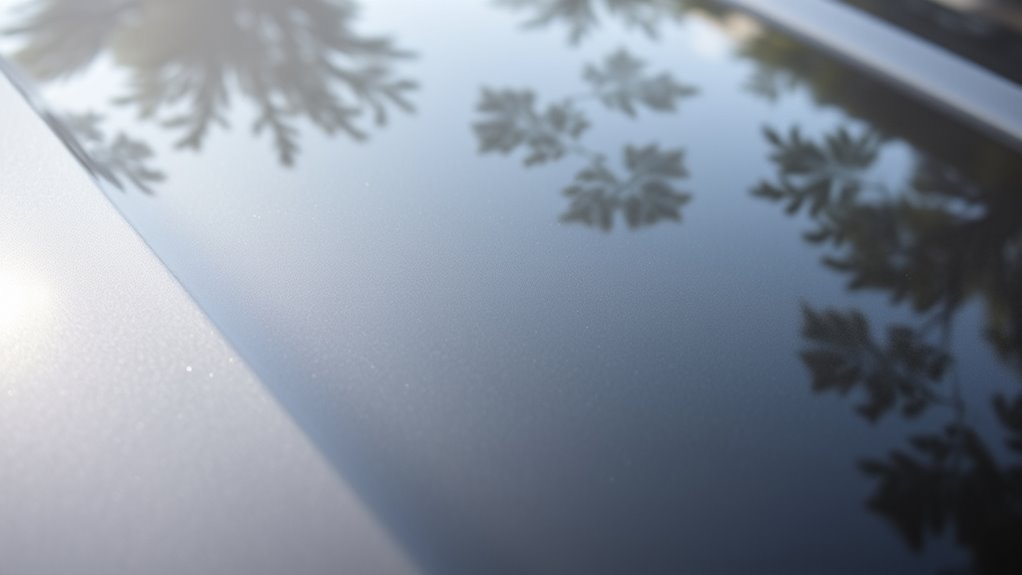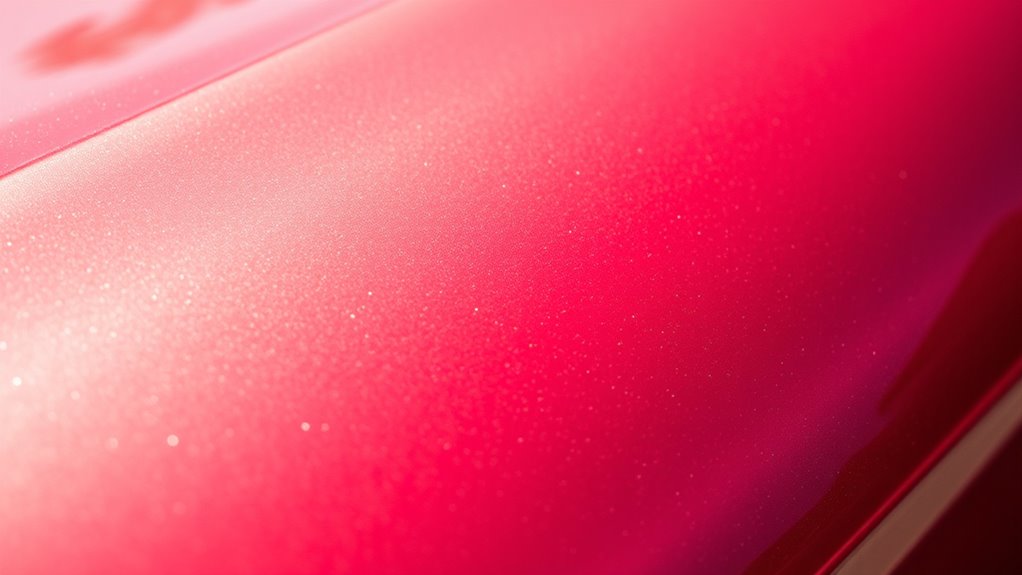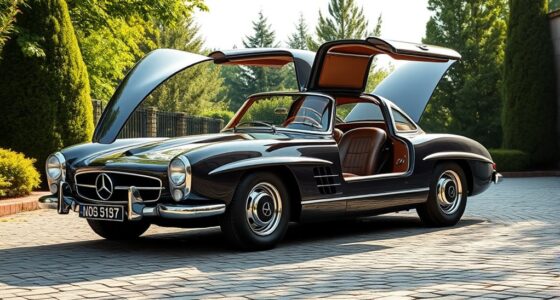The secret sauce behind self-healing car paint lies in its innovative polymer network embedded with microcapsules containing healing agents. When exposed to sunlight, the heat triggers these capsules to rupture, releasing the repair agents that flow into scratches and cracks, solidifying seamlessly. This smart process allows the paint to repair minor damage automatically and repeatedly, maintaining a pristine look over time. If you’d like to understand how this technology keeps your car looking new, keep exploring.
Key Takeaways
- The self-healing process is activated by heat from sunlight or ambient warmth, triggering polymer reactions to repair scratches.
- Embedded microcapsules in the paint rupture under stress, releasing healing agents that fill and solidify into minor damages.
- UV resistance in the coating prevents color fading and protects underlying layers from UV-induced cracking and brittleness.
- The advanced polymer network ensures repeated self-repair capability, maintaining the vehicle’s pristine appearance over time.
- Combining UV protection with self-healing materials extends the durability and reduces maintenance costs for car owners.

Imagine a car paint that can repair itself after minor scratches and chips, saving you time and money on repairs. That’s the promise of self-healing car paint, a revolutionary technology designed to keep your vehicle looking pristine without constant touch-ups. One of the key features that make this innovation so appealing is its impressive paint durability. Unlike traditional paints that can easily fade, chip, or succumb to environmental damage, self-healing coatings are engineered to withstand the rigors of everyday driving, whether it’s road debris, harsh weather, or UV exposure. This durability ensures your car maintains its sleek appearance longer, reducing the need for frequent repainting or touch-ups.
Self-healing car paint offers lasting durability against scratches, chips, and environmental damage.
UV resistance plays a vital role in this technology. Sunlight, especially ultraviolet rays, can accelerate paint degradation, causing colors to fade and surfaces to become brittle over time. Self-healing car paints are formulated with special additives that absorb or block UV radiation, protecting the underlying layers of the coating. This not only preserves the vibrant color but also prevents the paint from cracking or peeling prematurely. When you park your vehicle outside on a sunny day, you can rest assured that the UV-resistant properties of your self-healing paint actively combat the sun’s harmful effects, maintaining both the aesthetic appeal and structural integrity of your car’s finish.
The self-healing process itself is a fascinating combination of chemistry and material science. When minor scratches or chips occur, the paint’s unique polymer network responds by activating at a molecular level. Heat from the sun or even just ambient warmth triggers the healing process, causing the tiny, embedded microcapsules within the coating to rupture and release healing agents. These agents then flow into the damaged area, solidifying and seamlessly blending with the surrounding paint. This process effectively fills in scratches and chips, making them nearly invisible and restoring the surface’s smooth, glossy appearance. The best part? This self-repairing action can happen repeatedly, as long as the damage remains within the coating’s designed capacity.
Furthermore, advances in color stability have contributed to the longevity of self-healing car paints, ensuring that the colors stay vibrant and true over many years. In essence, self-healing car paint combines high paint durability with UV resistance to deliver a long-lasting, low-maintenance solution for car owners. It’s a smart innovation that keeps your vehicle looking newer, longer, without the constant need for touch-ups or repainting. By harnessing advanced materials and chemical reactions, this technology not only enhances your car’s appearance but also protects its value over time. So, next time you park outside on a sunny day, know that your car’s self-healing paint is working behind the scenes, ready to repair minor damage and keep your ride shining brightly.
Frequently Asked Questions
How Long Does Self-Healing Paint Last Before Needing a Reapplication?
You might wonder how long your self-healing paint lasts before needing reapplication. Typically, the paint’s durability ranges from 5 to 10 years, depending on factors like exposure to sunlight and weather conditions. Reapplication frequency varies but usually occurs every 7 to 10 years to maintain ideal protection. Taking good care of your car’s surface helps extend the paint’s lifespan and reduces the need for early reapplications, keeping your vehicle looking fresh longer.
Can Self-Healing Car Paint Be Applied to Existing Scratches?
Think of your car’s surface as a canvas waiting for its masterpiece. Yes, self-healing paint can be applied over existing scratches, acting like a gentle healer that blends imperfections smoothly. For scratch repair, it works best if you clean the area first. Keep in mind, paint durability varies, so reapplication might be necessary over time. This process restores your car’s beauty, turning flaws into a seamless finish.
Is Self-Healing Paint Resistant to Extreme Weather Conditions?
You’ll find that self-healing car paint offers good resistance to extreme weather conditions. It’s designed with UV resistance, protecting your car from sun damage, and boasts chemical durability, which helps it withstand harsh pollutants and acids. While no coating is completely invincible, this paint actively repairs minor scratches and maintains its integrity despite exposure to extreme heat, cold, or moisture, keeping your vehicle looking newer longer.
What Maintenance Is Required for Self-Healing Car Paint?
You should regularly wash your car gently to remove dirt and debris, which helps maintain the self-healing properties. For minor scratches, DIY touch ups using the same self-healing paint can work effectively, but for larger damages or professional finishes, seek expert application. Avoid harsh chemicals and abrasive tools, as they can damage the coating. Proper maintenance guarantees your self-healing paint stays effective and keeps your car looking its best.
Are There Any Vehicle Colors Incompatible With Self-Healing Paint?
Wondering about color compatibility and finish options for self-healing paint? You should know that most standard vehicle colors work well, but some very dark or metallic finishes might pose challenges. Bright, solid colors tend to show scratches less and respond better to self-healing properties. To guarantee ideal results, check with your manufacturer or specialist about specific color compatibility and available finish options, guaranteeing your car stays pristine and protected.
Conclusion
Now that you know the secret behind self-healing car paint, you can appreciate how science meets magic—almost like alchemy in modern times. Imagine, your car’s scratches mend themselves in the sun, saving you time and money. It’s a game-changer that makes car maintenance feel like a stroll through a futuristic garden. So next time you spot a tiny scratch, just relax—your car’s got this, and the sun’s doing the heavy lifting.










